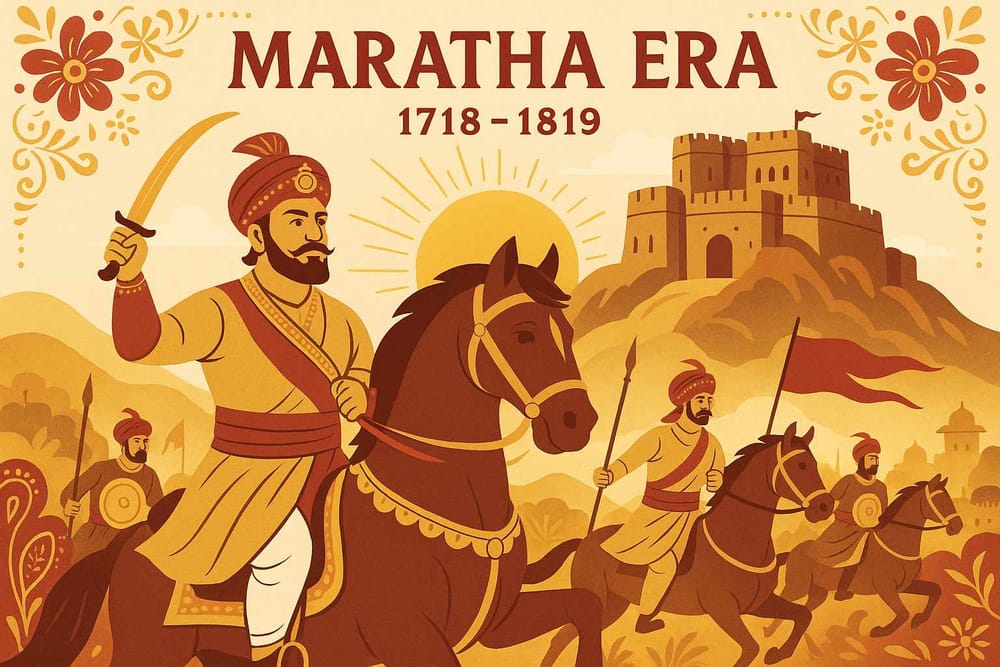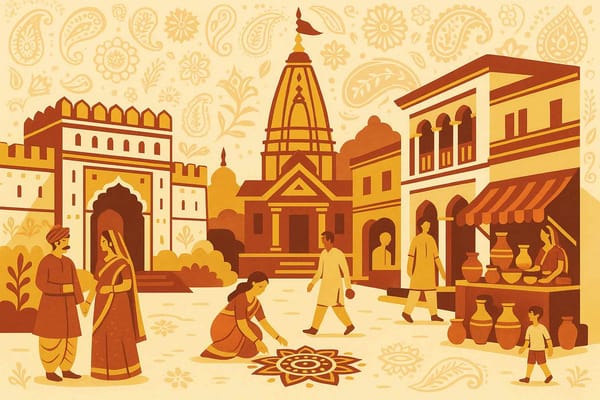
The Maratha Era 1718-1819: Explore Key Events-Figures-Legacy
Close your eyes for a moment and listen. Can you hear the thunder of hooves galloping across the Deccan? The spirited cry of 'Har Har Mahadev' echoing through the misty Sahyadri valleys? This isn't just a story from a textbook; it's the living, breathing soul of the Maratha Empire, a period that reshaped the destiny of Bharatvarsha. This was an era of incredible courage, sharp strategy, and an undying will for 'Swarajya'—self-rule. Let's journey back in time, not just to read history, but to feel the pride and understand the profound legacy left behind by these remarkable warriors and administrators.
The Dawn of a New Era: From Shivaji's Dream to Peshwa Power
The story, of course, begins with the great Chhatrapati Shivaji Maharaj, who lit the flame of independence in the 17th century. But as we move into the 18th century, this flame grew into a blazing fire under the guidance of the Peshwas. In 1713, a pivotal moment arrived when Chhatrapati Shahu appointed Balaji Vishwanath as his Peshwa (Prime Minister). This wasn't just a political appointment; it was the beginning of a new chapter that would see the Marathas rise from a regional kingdom to a dominant pan-Indian power.
Balaji Vishwanath was a master strategist. He understood that to build an empire, you need both might and diplomacy. One of his greatest achievements came in 1719, a year that truly shook the foundations of the crumbling Mughal Empire. The Marathas marched right into Delhi, the heart of Mughal power, deposed the emperor Farrukhsiyar, and secured the release of Shivaji's family, including Yesubai, Shahu’s mother, who had been held captive for decades. Imagine the emotional reunion and the powerful message this sent across India: the Marathas were here to protect their own and challenge the old order.
Triumphs, Trials, and the Test of Time
The Maratha Confederacy, as it came to be known, was a unique system of semi-independent states like the Gaekwads of Baroda, the Holkars of Indore, and the Scindias of Gwalior, all united under the Peshwa's leadership. This structure allowed for rapid expansion and efficient local governance.
However, the path was not without its thorns. The Maratha spirit was severely tested in a series of major conflicts that defined their story:
- The First Anglo-Maratha War (1775-1782): This was a testament to Maratha strength and unity. At a time when British influence was growing, the Marathas handed them a decisive defeat, restoring the pre-war balance of power. It showed the world that the empire was still a force to be reckoned with.
- Internal Strife and Shifting Alliances: The strength of the confederacy could also be its weakness. The early 1800s saw internal conflicts, like the Battle of Poona in 1802 where Yashwantrao Holkar defeated the combined forces of the Peshwa and the Scindias. These internal rivalries unfortunately created openings for external forces.
- The Second and Third Anglo-Maratha Wars (1803-1818): These later wars proved to be the empire's undoing. Faced with the superior resources and cunning strategies of the British East India Company, and weakened by internal divisions, the Marathas fought valiantly but ultimately succumbed. The Third Anglo-Maratha War ended in 1818 with the defeat of the last Peshwa, Bajirao II, and the dissolution of their great empire.
The Pillars of the Empire: Leaders Who Defined an Age
An empire is built by its people, and the Maratha era was blessed with leaders of incredible character and vision. While Shivaji Maharaj laid the foundation, many others carried the torch forward.
Bajirao I, the son of Balaji Vishwanath, was an undefeated general whose military genius is still studied today. He expanded the empire's boundaries with lightning-fast campaigns, establishing Maratha influence across North India. Then there was the formidable Mahadaji Shinde, who, after the devastating setback at Panipat, painstakingly rebuilt Maratha prestige in the north and even captured the mighty Gwalior fort in 1783.
And how can we forget the women of substance? Figures like Ahilyabai Holkar of Indore ruled with compassion and wisdom, becoming a symbol of 'Dharma' and good governance. She renovated temples across India, from Somnath to Kashi, and her reign is remembered as a golden age of peace and prosperity. These leaders show that the Maratha legacy was not just about war, but also about building a just and culturally rich society. The way these royal traditions shaped local celebrations and preserved our heritage is a lesson for all time.
A Legacy That Breathes in Modern India
Though the empire fell in 1818, its spirit never died. The Marathas were the last major Indian power to stand against the British, and their story is one of ultimate resistance and pride. They ended Mughal control over large parts of India and fostered a sense of regional identity and cultural self-respect that continues to resonate today.
Their administrative innovations influenced later governance models, and their patronage of arts, language, and festivals like Ganesh Chaturthi became deeply woven into the fabric of Indian culture. They showed us how to rule with both a sword and a sense of justice, respecting all faiths and traditions under their vast umbrella.
At Bhaktilipi, we are deeply inspired by this spirit of preserving our heritage. Our mission is to safeguard and share the timeless devotional literature and stories that form the bedrock of our culture. We believe that by digitizing these sacred texts, we are continuing the work of our ancestors, ensuring that their wisdom inspires generations to come.
Explore our collection of stories and discover the knowledge that enriches your spiritual life. Stay connected with our community on Facebook, Instagram, and YouTube for regular updates and a dose of inspiration. Join us in this beautiful journey of celebrating our timeless bhakti literature!
Reflections on the Maratha Saga: Understanding Its Deeper Meaning
When we look back at the Maratha era, several thoughts and questions naturally arise. What was its true importance in the grand tapestry of Indian history? The empire was significant because it acted as a bridge between the medieval and modern periods, challenging the old Mughal order and laying down principles of decentralized governance that find echoes in modern India. They proved that power could be rooted in regional identity and still command respect across the subcontinent.
Many wonder what truly led to the sunset on this great empire. It wasn't a single event, but a combination of factors. The relentless pressure from the rising British power, coupled with unfortunate internal conflicts among Maratha chiefs, weakened their collective strength. The final defeat in the Third Anglo-Maratha War was the culmination of these internal and external pressures.
Finally, we must ask what legacy the Marathas left for us. Their enduring legacy is one of resilience, cultural pride, and administrative foresight. The forts that stand tall on the hills of Maharashtra are not just stone structures; they are symbols of an unyielding spirit. The Maratha era reminds us of the importance of unity, the strength found in our traditions, and the timeless courage to fight for what is right.
A passionate group of people dedicated to preserving India's knowledge of Dharma, Karma, and Bhakti for ourselves and the world 🙏.
Comments
Related in

Maratha Era Influences Bulandshahr's Cultural Landscape
Have you ever walked through the lanes of an old city and felt the weight of history in the air? In the heart of Uttar Pradesh, Bulandshahr is one such place. Its story isn't just written in books; it's etched into the very fabric of its
